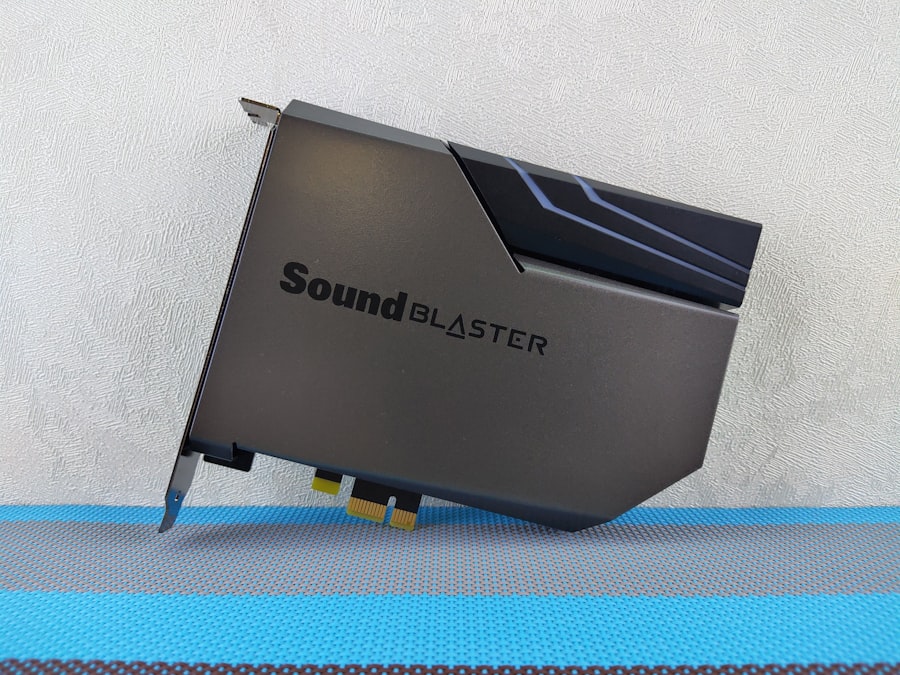Spatial audio is a revolutionary advancement in sound technology that creates a three-dimensional auditory experience, allowing listeners to perceive sound as if it is coming from various directions and distances. Unlike traditional stereo sound, which is limited to two channels, spatial audio utilizes multiple audio channels and advanced algorithms to simulate how sound behaves in the real world. This technology mimics the way humans naturally hear sounds, taking into account factors such as the shape of the ear, the position of the listener, and environmental acoustics.
By doing so, spatial audio provides a more immersive listening experience that can significantly enhance various forms of media, particularly in gaming and virtual reality. The essence of spatial audio lies in its ability to create a sense of presence and depth. It employs techniques such as binaural recording, which captures sound using two microphones placed in a way that mimics human ears, and object-based audio, which allows sound designers to place individual sound elements in a three-dimensional space.
This results in a more nuanced auditory landscape where players can discern the direction and distance of sounds, making them feel as though they are truly part of the game world. As technology continues to evolve, spatial audio is becoming increasingly accessible, with platforms like Dolby Atmos and Sony’s 3D Audio leading the charge in bringing this immersive experience to mainstream audiences.
Key Takeaways
- Spatial audio creates a 3D sound experience, allowing for more immersive and realistic audio in virtual reality games.
- Spatial audio enhances player engagement by creating a more immersive and interactive gaming experience.
- Spatial audio plays a crucial role in enhancing realism in virtual reality games by creating a more lifelike audio environment.
- Spatial audio contributes to immersive storytelling in games by creating a more realistic and engaging audio experience for players.
- The future of spatial audio in gaming looks promising, with advancements in technology and game development leading to even more realistic and immersive audio experiences for players.
Spatial Audio in Virtual Reality Games
The Power of Immersive Sound
In a VR horror game, for example, the sound of footsteps approaching from behind can trigger a visceral reaction, heightening tension and engagement. The ability to accurately locate sounds enhances the player’s sense of presence within the virtual world, making every encounter feel more immediate and impactful.
Dynamic Soundscapes and Navigational Aids
In a VR adventure game, spatial audio allows for dynamic soundscapes that respond to player actions and movements. As players navigate through a dense forest, they might hear birds chirping overhead or leaves rustling nearby. These sounds not only enrich the environment but also serve as navigational aids, guiding players toward objectives or alerting them to hidden dangers.
A Cohesive Experience
The integration of spatial audio in VR games creates a more cohesive experience where sound and visuals work in harmony, reinforcing the illusion of reality and encouraging players to explore their surroundings with greater curiosity and engagement.
The Impact of Spatial Audio on Player Engagement
The impact of spatial audio on player engagement cannot be overstated. By creating an immersive auditory environment, spatial audio captures players’ attention and keeps them invested in the gameplay experience. Research has shown that when players can accurately perceive sound directionality and distance, their emotional responses are heightened.
This heightened emotional engagement can lead to longer play sessions and increased satisfaction with the game overall. For example, in multiplayer games where communication is key, spatial audio allows players to hear teammates’ voices from specific locations, enhancing coordination and teamwork. Furthermore, spatial audio can influence player behavior by creating a sense of urgency or danger.
In fast-paced action games, the sound of an enemy’s weapon being fired from a specific direction can prompt players to react quickly, adding an element of thrill to the gameplay. This auditory feedback not only enhances the excitement but also encourages players to develop strategies based on sound cues. As players become more attuned to their auditory environment, they may find themselves more deeply immersed in the game world, leading to a more rewarding gaming experience.
The Role of Spatial Audio in Enhancing Realism
Realism is a critical aspect of modern gaming, and spatial audio plays a pivotal role in achieving this goal. By simulating how sound behaves in real life, spatial audio contributes to a more believable game environment. For instance, in a racing game, the roar of an engine can be perceived as coming from behind or ahead based on the player’s position relative to other vehicles.
This realistic sound placement not only enhances immersion but also affects gameplay dynamics; players can gauge their proximity to competitors through auditory cues alone. Additionally, spatial audio can enhance environmental storytelling by providing context through sound design. In an open-world game set in a bustling city, players might hear distant sirens, honking horns, or street performers playing music.
These sounds create a rich tapestry that reflects the vibrancy of the game world and helps players feel as though they are part of a living ecosystem. The attention to detail in sound design reinforces the visual elements of the game, creating a cohesive experience that draws players deeper into the narrative and setting.
Spatial Audio and Immersive Storytelling
Immersive storytelling is an essential element of modern gaming, and spatial audio serves as a powerful tool for enhancing narrative experiences. By integrating sound design with storytelling elements, developers can create moments that resonate emotionally with players. For example, in a narrative-driven game where choices impact the storyline, spatial audio can be used to convey critical information through environmental sounds or character dialogue that changes based on player decisions.
This dynamic use of sound adds layers to the narrative, making each player’s journey unique. Moreover, spatial audio can evoke specific emotions by manipulating soundscapes to match narrative themes. In a dramatic scene where a character faces loss or betrayal, subtle background sounds—such as fading music or distant echoes—can amplify the emotional weight of the moment.
This technique allows players to connect with characters on a deeper level, fostering empathy and investment in their journeys. By weaving spatial audio into storytelling mechanics, developers can create experiences that linger long after the game is over.
The Future of Spatial Audio in Gaming
As technology continues to advance at an unprecedented pace, the future of spatial audio in gaming looks promising. With developments in hardware and software capabilities, we can expect even more sophisticated implementations of spatial audio that push the boundaries of immersion. For instance, advancements in head-tracking technology will allow for real-time adjustments to sound placement based on player movements, creating an even more seamless auditory experience.
This could lead to games where players feel as though they are truly inside the world rather than merely observing it from an external perspective. Additionally, as cloud gaming becomes more prevalent, developers will have greater opportunities to experiment with spatial audio across various platforms without being constrained by hardware limitations.
As developers continue to explore new creative avenues for integrating sound into gameplay mechanics and storytelling, we may witness a new era of gaming where spatial audio becomes an integral part of every player’s journey.
Implementing Spatial Audio in Game Development
Implementing spatial audio in game development requires careful consideration and expertise across multiple disciplines. Sound designers must collaborate closely with developers to ensure that audio elements are seamlessly integrated into the gameplay experience. This involves not only creating high-quality sound assets but also utilizing advanced tools and software that support spatial audio technologies.
Game engines like Unity and Unreal Engine have begun incorporating built-in support for spatial audio systems such as Wwise and FMOD, allowing developers to easily implement complex soundscapes. Moreover, testing is crucial when integrating spatial audio into games. Developers must conduct extensive playtesting sessions to gather feedback on how well players perceive and interact with sound elements within the game world.
This iterative process allows for fine-tuning of audio placement and effects based on player experiences. Additionally, developers should consider accessibility options for players who may have hearing impairments; providing visual cues or alternative feedback mechanisms can ensure that all players can enjoy the benefits of spatial audio.
The Psychological Effects of Spatial Audio on Players
The psychological effects of spatial audio on players are profound and multifaceted. Research indicates that immersive auditory experiences can significantly influence mood and emotional responses during gameplay. For instance, when players are enveloped in a rich soundscape that accurately reflects their environment, they are more likely to feel engaged and connected to the game world.
This connection can lead to heightened levels of enjoyment and satisfaction as players navigate challenges and explore narratives. Furthermore, spatial audio can evoke physiological responses such as increased heart rate or adrenaline release during intense moments in games. The ability to hear sounds approaching from different directions can trigger instinctual reactions akin to those experienced in real-life situations—such as fight-or-flight responses—enhancing the thrill of gameplay.
This psychological engagement not only makes games more enjoyable but also fosters a deeper connection between players and their virtual experiences, ultimately shaping how they perceive and interact with digital worlds. In conclusion, spatial audio represents a significant leap forward in how we experience sound within gaming environments. Its ability to create immersive experiences enhances player engagement while contributing to realism and storytelling depth.
As technology continues to evolve, we can anticipate even more innovative applications of spatial audio that will redefine our understanding of interactive entertainment.
Spatial audio technology is revolutionizing the way we experience immersive games, as discussed in the article “The Role of Spatial Audio in Improving Immersive Game Experiences.” This technology enhances the overall gaming experience by providing realistic sound effects that correspond to the player’s movements within the game environment. For more insights on the latest trends in technology, check out this article on predicted trends for 2023.
FAQs
What is spatial audio?
Spatial audio is a technology that creates a three-dimensional sound environment, allowing users to perceive the direction and distance of sound sources in a virtual space.
How does spatial audio improve immersive game experiences?
Spatial audio enhances immersive game experiences by providing more realistic and accurate sound cues, allowing players to better locate and react to in-game events and objects.
What are the benefits of using spatial audio in games?
The benefits of using spatial audio in games include increased immersion, better situational awareness, enhanced gameplay experiences, and improved overall audio quality.
What are some examples of games that utilize spatial audio technology?
Some examples of games that utilize spatial audio technology include “The Last of Us Part II,” “Hellblade: Senua’s Sacrifice,” and “Half-Life: Alyx.”
How does spatial audio contribute to virtual reality (VR) gaming?
Spatial audio contributes to VR gaming by providing more realistic and immersive audio experiences, helping to create a sense of presence and spatial awareness within the virtual environment.
What are some common techniques used to implement spatial audio in games?
Common techniques used to implement spatial audio in games include binaural audio processing, sound propagation algorithms, and dynamic audio mixing based on the player’s position and orientation.



